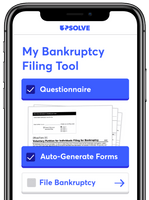Tax Credits and Bankruptcy
Upsolve is a nonprofit that helps you eliminate your debt with our free bankruptcy filing tool. Think TurboTax for bankruptcy. You could be debt-free in as little as 4 months. Featured in Forbes 4x and funded by institutions like Harvard University — so we’ll never ask you for a credit card. See if you qualify
Tax credits reduce the total tax owed by the individual or family claiming the credit. Many low-income families have all or a portion of such a tax credit refunded to them once their tax return is filed and their eligibility to claim the credit confirmed by the Internal Revenue Service. This article will review some of the most commonly used tax credits available to low-income individuals and how these credits are treated in a Chapter 7 bankruptcy.
Written by Attorney Eva Bacevice.
Updated May 15, 2025
Table of Contents
Tax credits reduce the total tax owed by the individual or family claiming the credit. Many low-income families have all or a portion of such a tax credit refunded to them once their tax return is filed and their eligibility to claim the credit confirmed by the Internal Revenue Service. This article will review some of the most commonly used tax credits available to low-income individuals and how these credits are treated in a Chapter 7 bankruptcy.
Earned Income Tax Credit
One of the most common tax credits available to low-income filers is called the Earned Income Tax Credit, or “EIC.” which can result in a substantial tax refund. There is no specific exemption for EIC in the federal exemptions, but many states do have them. If your state offers this exemption you can protect your EIC tax refund up to the amount allowed by the exemption, even if you haven’t received the funds yet. You can also use a wildcard exemption or (if you’ve received it already) the cash exemption to protect this, if available under state law or if you’re using the federal exemptions.
If your EIC amount is higher than the amount you can exempt, you would lose the additional amount in your Chapter 7. If you find yourself in these circumstances it makes sense to speak with a bankruptcy attorney about your options, which could include adjusting your withholdings before you file or waiting to file until after you have received the EIC and spent it on allowable necessities, like rent, food, and clothing.
Child and Dependent Care Credit
The Child and Dependent Care Credit is available to qualifying individuals or families who spend money on child care so that you, and your spouse, if any, can work. To qualify you’ll need to meet several conditions. This credit can cover a percentage (20% to 35%) of some or all of the dependent care expenses that you pay. It is designed so that families with lower income qualify for a large percentage under the credit, whereas those with higher income get a smaller percentage.
Just like the EIC credit, there is no specific exemption for this under federal exemptions so you’ll need to look to your state laws to see if there is an exemption for either the Child and Dependent Care Credit as well as the Child Tax Credit. If you are following federal bankruptcy exemptions, here again, you would need to use the wildcard exemption.
Premium Tax Credit (Affordable Care Act)
The Premium Tax Credit (PTC) is a refundable tax credit that helps eligible people and families pay the premiums for their health insurance purchased through the Health Insurance Marketplace as required by the Affordable Care Act. If you can’t afford health insurance due to financial hardship you might qualify for a hardship exemption to avoid a tax penalty. One of the specific circumstances listed as qualifying is if you have filed for bankruptcy in the last six months.
Health Coverage Tax Credit
The Health Coverage Tax Credit (HCTC) is a refundable tax credit designed to offset the cost of monthly health insurance premiums, up to 72.5%. You can choose to receive this in advance as monthly payments, or you can claim your HCTC when you file your taxes, which could increase your tax refund or lower the amount you owe. If this does increase your refund you can protect it with an available wildcard exemption, if any.
Protecting tax credits when filing bankruptcy
As noted, none of the tax credits listed above are protected by explicit federal bankruptcy exemptions, but they may be protected by individual state exemptions. If not, paying attention to timing may be your best bet for protecting your tax credit.
With Exemptions
When you file for bankruptcy your property goes into the bankruptcy estate, and your bankruptcy trustee has the right to sell the property to share the proceeds with your creditors. You won’t lose most (or even all) of your property, however, because that wouldn’t allow for a fresh start after bankruptcy.
Instead, you can protect your property through the use of special bankruptcy laws, called exemptions, for varying amounts. Every state has its own set of state exemptions that set the amounts you can protect for various items. There is also a set of federal bankruptcy exemptions, and some states allow you to choose which you want to apply in your bankruptcy case.
Many states have specifically addressed tax credits in their allowable exemptions. If your state does not currently offer this protection, please feel empowered to call your state legislature to ask about creating these protections. If your state does not offer a specific exemption for a particular tax credit or you are using federal bankruptcy exemptions instead, you’re limited to protecting any tax refund with your wildcard exemption.
With Timing
It’s important to consider the timing factor in these circumstances. If you are not going to be able to protect all, or most, of your tax refund with your allowable exemptions, it might make sense to wait to file your bankruptcy case until after you have received your tax refund. Keep in mind, however, that you’ll only be able to protect the funds if you spend them before you file. The catch here is that you’ll need to spend those funds on allowable expenses, like rent and other necessities. You’ll want to make sure you aren’t purchasing anything that could be viewed as a luxury item. You should also keep all of your receipts and list any purchased assets on your Schedule A/B when you do file your case.
Conclusion
There are a lot of factors that go into your decision to file bankruptcy, including when it makes the most sense for you to do so. The tax credits discussed above may factor significantly in the size of your tax refund, and if so, could impact the timing of your case to maximize the amount that you can protect. It’s a good idea to learn about all of the tax credits you might benefit from and take them into consideration before filing your case.












